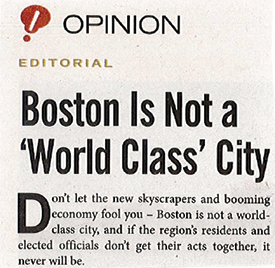
CBRE/New England
The May 28, 2018 Banker & Tradesman editorial is shocking:
Reasons given were housing costs, travel times and small size (48 square miles). I could not disagree more.
In response, this article will start with a historical perspective of where Boston has come from, the changes that have taken place and close with examples from the market that prove that Boston is one of the best places in which to live, work and invest.
Historical Perspective
Boston’s initial growth involving commercial property took place in the 1890-1910 timeframe, funded by what were known as Massachusetts trusts. Massachusetts trusts pooled investor funds and built major office buildings. Prominent trustees involved with these investor funds include George DeBlois, William Minot and Moses Williams. The Boston Real Estate Trust and Boston Ground Rent Trust created the real estate investment trust industry in 1960.
After great growth, Boston fell on hard times caused by an out of balance real estate tax structure: Real estate taxes accounted for as much as 50% of a property’s income. With out of balance tax burdens, money evaporated from the city with the sale of many trust assets and reinvestment outside of Boston.
It was the action of Prudential Insurance Company in 1962 (Chapter 121 A) and visionary business people like Arthur Altman and Robert Beal in 1980 (Proposition 2½) that turned the real estate tax structure around. City officials such as the mayor John Collins/Edward Logue team that created the BRA (now BPDA) and the actions of the Cambridge Redevelopment Authority provided the infrastructure to make Boston the world-class city it is today. Master planning in its best sense helped to set the ground work for what we currently have. In addition, the Big Dig opened up abandoned rail land in the Seaport for a new ‘city within a city.’
Market Change
In 1999, the Seaport contained 4 million s/f of office space, which has tripled to 13.3 million s/f as of Q2 2018. East Cambridge, with 8 million s/f of office space in 1999, contains 25.48 million of office/lab space as of Q2 2018.
Even more amazing is the change in rent levels. Seaport office rents were $35.21 per s/f in 1999, and as of Q1 2018, office rents nearly doubled to $68.65 per s/f for Class A space. East Cambridge office rents were $40.41 per s/f in 1999 and have more than doubled to $95.26 per s/f as of Q2 2018. Lab space, which was a non-existent market, was created with an $87.84 per s/f NNN rent market as of Q2 2018.
This is despite the impacts of the Great Recession, which started in December 2007. Recovery did not place until Q2 2011. Remember, Seaport rents in Q2 2011 were about the same at $36.77 per s/f as in 1999.
Boston’s world-class stature is new. It began to develop some six years ago and continues to this day. Please keep in mind that in Q1 2011 the Boston industrial market was on its ear with greater than 21.2% vacancy. Vacancy is 8% today and total overall industrial vacancy is only 6.2%. This is what a world-class city can do. It sets the image for success.
Conclusion
Just look at what is going on. Capital within the city is worldwide capital; not that of just local Boston trusts. Boston’s current stability make it an attractive place to invest. Most certainly Amazon would not have leased from WS Development in the Seaport if Boston was “not a ‘world-class’ city.”
Just look at what MIT is doing. They are rebuilding Kendall Sq., the entry to the city of Cambridge. Under construction is a five-building complex known as SOMA (South on Main) with 14-25-story towers, a six-level 1,200-car underground garage, and 1.787 million s/f of office/lab/residential and retail space. This is equivalent in size to the John Hancock tower.
And this is only the start. Other major developments will take place. The only red light I can see is the out of balance of construction costs and the entire cost versus value equation. Basic economics of new high-rise residential housing are under challenge, and it is only Boston’s strong condominium market and pricing that can carry the risk.
I have completed market studies worldwide. I have seen other cities with their density of construction, and traffic congestion, which carry the same issues as outlined in the Banker & Tradesman article. No one would ever say that London (West End), Shanghai and Beijing are not world-class cities. Boston most certainly is, and the numbers presented herein prove it.
Webster Collins, MAI, CRE, FRICS is an executive vice president within the Valuation & Advisory Group’s leadership team of CBRE/New England, Boston.








